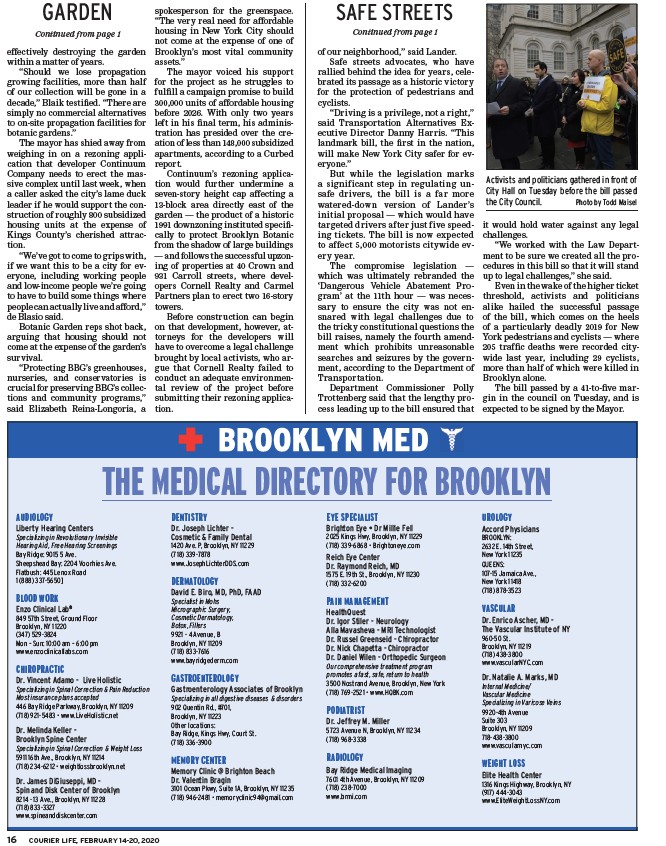
GARDEN
effectively destroying the garden
within a matter of years.
“Should we lose propagation
growing facilities, more than half
of our collection will be gone in a
decade,” Blaik testifi ed. “There are
simply no commercial alternatives
to on-site propagation facilities for
botanic gardens.”
The mayor has shied away from
weighing in on a rezoning application
that developer Continuum
Company needs to erect the massive
complex until last week, when
a caller asked the city’s lame duck
leader if he would support the construction
of roughly 800 subsidized
housing units at the expense of
Kings County’s cherished attraction.
“We’ve got to come to grips with,
if we want this to be a city for everyone,
including working people
and low-income people we’re going
to have to build some things where
people can actually live and afford,”
de Blasio said.
Botanic Garden reps shot back,
arguing that housing should not
come at the expense of the garden’s
survival.
“Protecting BBG’s greenhouses,
nurseries, and conservatories is
crucial for preserving BBG’s collections
and community programs,”
said Elizabeth Reina-Longoria, a
spokesperson for the greenspace.
“The very real need for affordable
housing in New York City should
not come at the expense of one of
Brooklyn’s most vital community
assets.”
��������������������������������������������������������������������
COURIER L 16 IFE, FEBRUARY 14-20, 2020
The mayor voiced his support
for the project as he struggles to
fulfi ll a campaign promise to build
300,000 units of affordable housing
before 2026. With only two years
left in his fi nal term, his administration
has presided over the creation
of less than 148,000 subsidized
apartments, according to a Curbed
report.
Continuum’s rezoning application
would further undermine a
seven-story height cap affecting a
13-block area directly east of the
garden — the product of a historic
1991 downzoning instituted specifi -
cally to protect Brooklyn Botanic
from the shadow of large buildings
— and follows the successful upzoning
of properties at 40 Crown and
931 Carroll streets, where developers
Cornell Realty and Carmel
Partners plan to erect two 16-story
towers.
Before construction can begin
on that development, however, attorneys
for the developers will
have to overcome a legal challenge
brought by local activists, who argue
that Cornell Realty failed to
conduct an adequate environmental
review of the project before
submitting their rezoning application.
Continued from page 1
SAFE STREETS
of our neighborhood,” said Lander.
Safe streets advocates, who have
rallied behind the idea for years, celebrated
its passage as a historic victory
for the protection of pedestrians and
cyclists.
“Driving is a privilege, not a right,”
said Transportation Alternatives Executive
Director Danny Harris. “This
landmark bill, the fi rst in the nation,
will make New York City safer for everyone.”
But while the legislation marks
a significant step in regulating unsafe
drivers, the bill is a far more
watered-down version of Lander’s
initial proposal — which would have
targeted drivers after just five speeding
tickets. The bill is now expected
to affect 5,000 motorists citywide every
year.
The compromise legislation —
which was ultimately rebranded the
‘Dangerous Vehicle Abatement Program’
at the 11th hour — was necessary
to ensure the city was not ensnared
with legal challenges due to
the tricky constitutional questions the
bill raises, namely the fourth amendment
which prohibits unreasonable
searches and seizures by the government,
according to the Department of
Transportation.
Department Commissioner Polly
Trottenberg said that the lengthy process
leading up to the bill ensured that
it would hold water against any legal
challenges.
“We worked with the Law Department
to be sure we created all the procedures
in this bill so that it will stand
up to legal challenges,” she said.
Even in the wake of the higher ticket
threshold, activists and politicians
alike hailed the successful passage
of the bill, which comes on the heels
of a particularly deadly 2019 for New
York pedestrians and cyclists — where
205 traffi c deaths were recorded citywide
last year, including 29 cyclists,
more than half of which were killed in
Brooklyn alone.
The bill passed by a 41-to-fi ve margin
in the council on Tuesday, and is
expected to be signed by the Mayor.
Continued from page 1
Activists and politicians gathered in front of
City Hall on Tuesday before the bill passed
the City Council. Photo by Todd Maisel
������������������
����������������������������������������������
���������������������������������������������������������������������������������� ��
��������������������������������������������������������������������������
��������������������������������������������
��������������������������������������������������������������������
���������������������������������������������������� �� ��
����������������������������������
��������������������
������������������������������������
������������������������������������������������������������
��������������������������������������
������������������������������
������������������������������������������������������������
���������������������������������������������������� ��
������������������������
��������������������������������������������������������������������
������������������������������������������������������������������������������������������������������
����������������������������������������������������������
����������������������������������������������������������������������������������
��������������������������������������������������������������������������
������������������������������������������ �� ��
������������������������������������������
������������������������������������������������������������������������������������������������
��������������������������������������������������������������������
������������������������������������������������������������������������������
����������������������������������������������������
����������������������������������������������������������������
��������������������������������������������������������������������������
������������������������������ �� ��
����������������������������������������������������
������������������
������������������������������������������ �� ��
������������������������������������������������
��������������������������������������������������������������
������������������������������ �� ��
������������������������������������������������
����������������������
��������������������������������������������������������
����������������������������������������
��������������������������������������������
����������������������������������������������
����������������������������
������������������������������������
������������������������������������
������������������������������ �� ��
����������������������������������������
��������������������������������
������������������������������������������������������������������������������
������������������������������������������������������������������������������������������������������
����������������������������������������������
������������������������������������
������������������������������������ �� ��
��������������������������������������������������������������
����������������������������
��������������������������
������������������������������������������������������������
��������������������������������������
����������������������������������������������������������������������������������������������
������������������������������������������������������������������������������������
����������������������������
����������������������������������������������������������
��������������������������������������������������������������������
����������������������������������������������������������������
����������������������������������
������������������������������������������
����������������������������������������������������������������������������
����������������������������
������������������������������
������������������������
������������������������������������������������������
������������������������������������������������������������������
����������������������������������������������������������������������
����������������������������������������������������������������
��������������������������������������������������������������������������
��������������������������������������������������������������������������
������������������������������������������������������������������������������
��������������������������������������������������������������������������������
����������������������������������������������������������
��������������������
������������������������������������������
����������������������������������������������������������������������
������������������������������ �� ��
������������������
��������������������������������������������������
��������������������������������������������������������������������������
������������������������������ �� ��
������������������������
��������������
����������������������������������
���������������������� �� �� ��
�������������������������������������������� �� ��
����������������������������
������������������ �� �� ��
�������������������������������������������� �� ��
����������������������������
����������������������������
������������������
����������������������������������������������
��������������������������������������������������������
���������������������� �� �� ��
����������������������������������������
������������������������������ �� ��
��������������������������������������
������������������������������������������������
��������������������������������������
������������������������������������
������������������������������������������������������������
���������������������������������� �� ��
���������������������� �� �� ��
�������������������������������������� �� ��
�������������������������� �� ��
��������������������������������������
������������������������
����������������������������������������
��������������������������������������������������������������������
������������������������������ �� ��
��������������������������������������������������